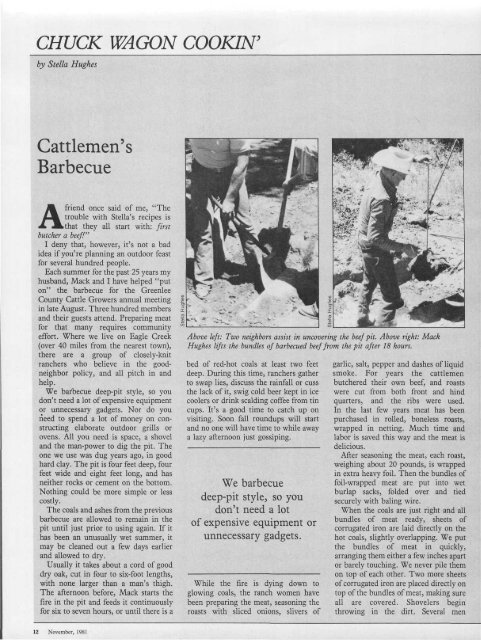fea I >. • - Desert Magazine of the Southwest
fea I >. • - Desert Magazine of the Southwest
fea I >. • - Desert Magazine of the Southwest
You also want an ePaper? Increase the reach of your titles
YUMPU automatically turns print PDFs into web optimized ePapers that Google loves.
CHUCK WAGON COOKIN'<br />
by Stella Hughes<br />
Cattlemen's<br />
Barbecue<br />
Afriend once said <strong>of</strong> me, "The<br />
trouble with Stella's recipes is<br />
that <strong>the</strong>y all start with: first<br />
butcher a beef!"<br />
I deny that, however, it's not a bad<br />
idea if you're planning an outdoor <strong>fea</strong>st<br />
for several hundred people.<br />
Each summer for <strong>the</strong> past 25 years my<br />
husband, Mack and I have helped "put<br />
on" <strong>the</strong> barbecue for <strong>the</strong> Greenlee<br />
County Cattle Growers annual meeting<br />
in late August. Three hundred members<br />
and <strong>the</strong>ir guests attend. Preparing meat<br />
for that many requires community<br />
effort. Where we live on Eagle Creek<br />
(over 40 miles from <strong>the</strong> nearest town),<br />
<strong>the</strong>re are a group <strong>of</strong> closely-knit<br />
ranchers who believe in <strong>the</strong> goodneighbor<br />
policy, and all pitch in and<br />
help.<br />
We barbecue deep-pit style, so you<br />
don't need a lot <strong>of</strong> expensive equipment<br />
or unnecessary gadgets. Nor do you<br />
need to spend a lot <strong>of</strong> money on constructing<br />
elaborate outdoor grills or<br />
ovens. All you need is space, a shovel<br />
and <strong>the</strong> man-power to dig <strong>the</strong> pit. The<br />
one we use was dug years ago, in good<br />
hard clay. The pit is four feet deep, four<br />
feet wide and eight feet long, and has<br />
nei<strong>the</strong>r rocks or cement on <strong>the</strong> bottom.<br />
Nothing could be more simple or less<br />
costly.<br />
The coals and ashes from <strong>the</strong> previous<br />
barbecue are allowed to remain in <strong>the</strong><br />
pit until just prior to using again. If it<br />
has been an unusually wet summer, it<br />
may be cleaned out a few days earlier<br />
and allowed to dry.<br />
Usually it takes about a cord <strong>of</strong> good<br />
dry oak, cut in four to six-foot lengths,<br />
with none larger than a man's thigh.<br />
The afternoon before, Mack starts <strong>the</strong><br />
fire in <strong>the</strong> pit and feeds it continuously<br />
for six to seven hours, or until <strong>the</strong>re is a<br />
12 November, 1981<br />
Above left: Two neighbors assist in uncovering <strong>the</strong> beef pit. Above right: Mack<br />
Hughes lifts <strong>the</strong> bundles <strong>of</strong> barbecued beef from <strong>the</strong> pit after 18 hours.<br />
bed <strong>of</strong> red-hot coals at least two feet<br />
deep. During this time, ranchers ga<strong>the</strong>r<br />
to swap lies, discuss <strong>the</strong> rainfall or cuss<br />
<strong>the</strong> lack <strong>of</strong> it, swig cold beer kept in ice<br />
coolers or drink scalding c<strong>of</strong>fee from tin<br />
cups. It's a good time to catch up on<br />
visiting. Soon fall roundups will start<br />
and no one will have time to while away<br />
a lazy afternoon just gossiping.<br />
We barbecue<br />
deep-pit style, so you<br />
don't need a lot<br />
<strong>of</strong> expensive equipment or<br />
unnecessary gadgets.<br />
While <strong>the</strong> fire is dying down to<br />
glowing coals, <strong>the</strong> ranch women have<br />
been preparing <strong>the</strong> meat, seasoning <strong>the</strong><br />
roasts with sliced onions, slivers <strong>of</strong><br />
garlic, salt, pepper and dashes <strong>of</strong> liquid<br />
smoke. For years <strong>the</strong> cattlemen<br />
butchered <strong>the</strong>ir own beef, and roasts<br />
were cut from both front and hind<br />
quarters, and <strong>the</strong> ribs were used.<br />
In <strong>the</strong> last few years meat has been<br />
purchased in rolled, boneless roasts,<br />
wrapped in netting. Much time and<br />
labor is saved this way and <strong>the</strong> meat is<br />
delicious.<br />
After seasoning <strong>the</strong> meat, each roast,<br />
weighing about 20 pounds, is wrapped<br />
in extra heavy foil. Then <strong>the</strong> bundles <strong>of</strong><br />
foil-wrapped meat are put into wet<br />
burlap sacks, folded over and tied<br />
securely with baling wire.<br />
When <strong>the</strong> coals are just right and all<br />
bundles <strong>of</strong> meat ready, sheets <strong>of</strong><br />
corrugated iron are laid directly on <strong>the</strong><br />
hot coals, slightly overlapping. We put<br />
<strong>the</strong> bundles <strong>of</strong> meat in quickly,<br />
arranging <strong>the</strong>m ei<strong>the</strong>r a few inches apart<br />
or barely touching. We never pile <strong>the</strong>m<br />
on top <strong>of</strong> each o<strong>the</strong>r. Two more sheets<br />
<strong>of</strong> corrugated iron are placed directly on<br />
top <strong>of</strong> <strong>the</strong> bundles <strong>of</strong> meat, making sure<br />
all are covered. Shovelers begin<br />
throwing in <strong>the</strong> dirt. Several men

















